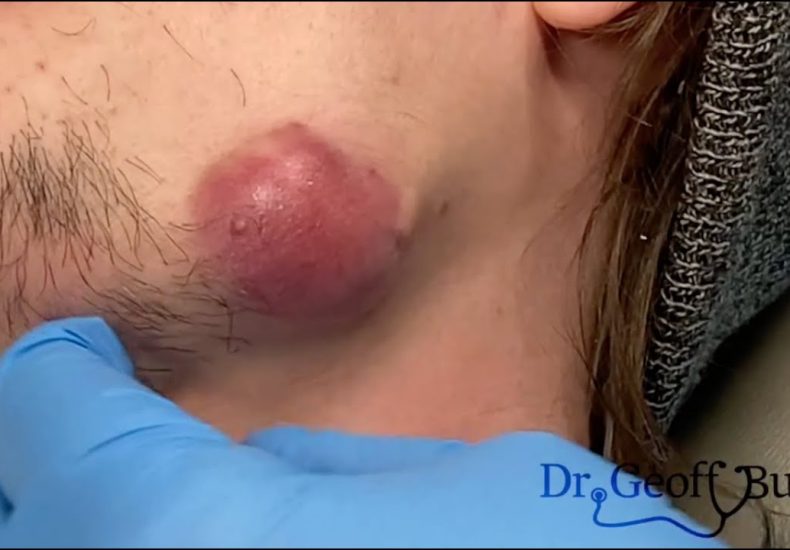
Drainage of an infected cyst on the jaw line
Drainage of an infected cyst on the jaw line
Please scroll down to watch the video.👇👇
Drainage of an infected cyst on the jawline is a medical procedure that should only be done by a healthcare provider due to the sensitive location, risk of scarring, and proximity to important facial nerves. Here’s a step-by-step overview of how professionals manage this procedure, along with references.
⚠️ WARNING:
Do NOT attempt to drain a cyst yourself, especially on the face or jawline. Improper drainage can cause:
-
Worsening infection
-
Nerve damage
-
Permanent scarring
-
Cellulitis or abscess formation
-
Risk of spreading infection to deeper tissues
✅ Professional Drainage of an Infected Cyst (Facial Area)
1. Medical Evaluation
-
A provider examines the size, depth, and signs of infection (redness, warmth, swelling, pus).
-
Imaging (ultrasound or CT) may be done for deep or complex cysts.
📖 Reference: American Family Physician – Skin Cyst Management
2. Anesthesia and Prep
-
Skin is cleaned with antiseptic (chlorhexidine or iodine).
-
Local anesthetic (like lidocaine) is injected to numb the area.
-
Antibiotics may be started before or after if the infection is spreading.
3. Incision and Drainage (I&D)
-
A small incision is made with a sterile scalpel at the most fluctuant (soft) part of the cyst.
-
Pus and infected fluid are gently drained.
-
The provider may remove the cyst wall or contents if feasible (only once infection subsides), or schedule excision later.
📖 Reference: StatPearls – Incision and Drainage
4. Irrigation and Packing
-
The cavity is flushed with saline.
-
A sterile dressing or iodoform gauze may be packed inside to prevent premature closure and allow continued drainage.
-
Packing is usually removed in 1–3 days.
5. Aftercare
-
Apply warm compresses to reduce swelling.
-
Clean the area as advised by your doctor.
-
Return for follow-up to monitor healing and possibly schedule cyst removal once the infection clears.
📖 Mayo Clinic – Sebaceous Cyst Care
❗ When to Seek Immediate Medical Help
-
Spreading redness or warmth
-
Fever or chills
-
Severe facial pain or swelling
-
Vision changes
-
Trouble swallowing or breathing
💬 Summary:
Treating an infected cyst on the jawline involves sterile incision and drainage, antibiotic therapy, and careful aftercare. Facial cysts should never be treated at home due to the risk of complications.
Draining an infected cyst on the jawline is a delicate procedure due to the area’s sensitivity and the proximity to facial nerves. It’s imperative that this procedure is performed by a qualified healthcare professional to minimize risks and ensure proper healing. Below is a comprehensive overview of the process, including references to authoritative medical sources.
🩺 Professional Drainage Procedure for an Infected Jawline Cyst
1. Clinical Assessment
-
Diagnosis: The healthcare provider will examine the cyst to determine its type (commonly an epidermoid or sebaceous cyst) and assess signs of infection such as redness, swelling, warmth, and pus accumulation.
-
Imaging: In certain cases, imaging studies like ultrasound or CT scans may be utilized to evaluate the cyst’s depth and involvement with adjacent structures.
2. Preparation and Anesthesia
-
Sterilization: The skin overlying the cyst is cleansed with an antiseptic solution to prevent infection.
-
Anesthesia: Local anesthesia is administered to numb the area, ensuring patient comfort during the procedure.
3. Incision and Drainage (I&D)
-
Incision: A small cut is made over the cyst to access the infected contents.
-
Drainage: Gentle pressure is applied to express the pus and keratinous material from the cyst cavity.
-
Note: While I&D alleviates acute symptoms, it doesn’t remove the cyst wall, which may lead to recurrence. Definitive treatment often involves complete surgical excision of the cyst capsule once the infection has resolved.
4. Post-Procedure Care
-
Packing: In some cases, the cavity may be packed with sterile gauze to promote continued drainage and prevent premature closure.
-
Dressing: A sterile dressing is applied to protect the site.
-
Antibiotics: If there’s evidence of spreading infection or systemic symptoms, oral antibiotics may be prescribed.
-
Follow-Up: Patients are advised to return for evaluation and possible removal of packing material within 24 to 48 hours.
5. Definitive Surgical Excision
-
Timing: Once the acute infection has subsided, complete surgical removal of the cyst wall is recommended to prevent recurrence.
-
Technique: A minimal excision technique may be employed, involving a small incision to extract the entire cyst capsule.
⚠️ Important Considerations
-
Avoid Self-Treatment: Attempting to drain a cyst at home can lead to complications such as infection spread, scarring, and damage to underlying structures.
-
Seek Prompt Medical Attention: If you notice signs of infection or rapid growth in a cyst, consult a healthcare provider promptly.
📚 References
Leave a Reply